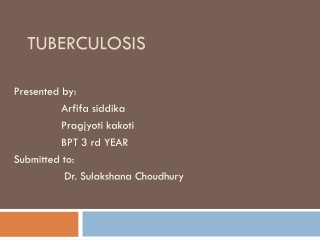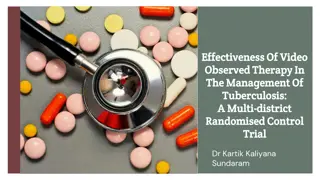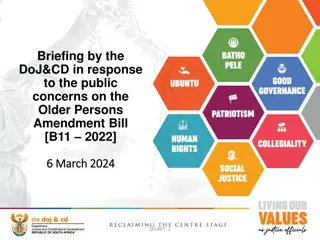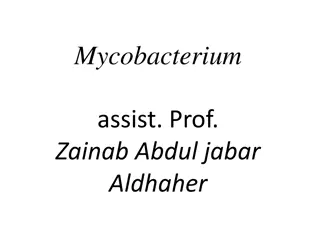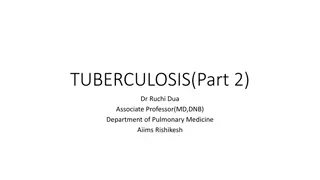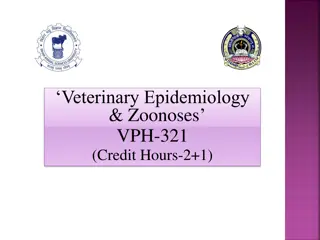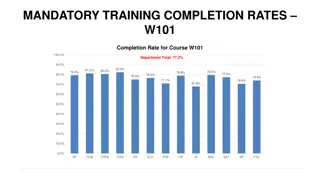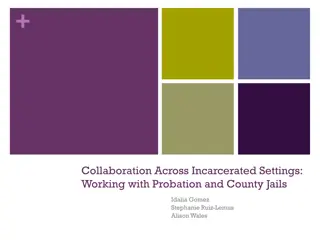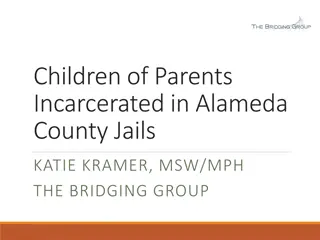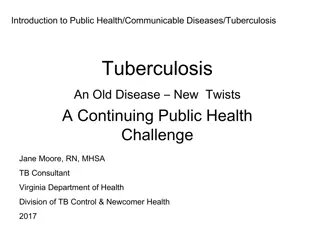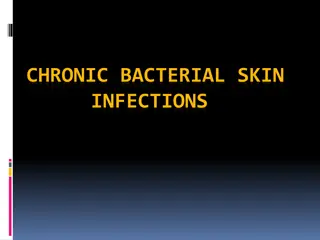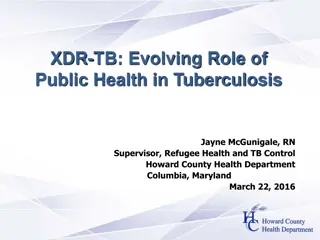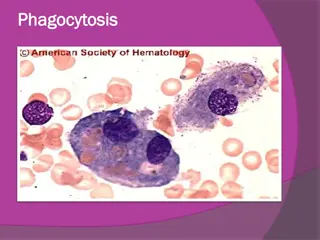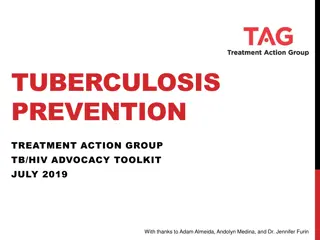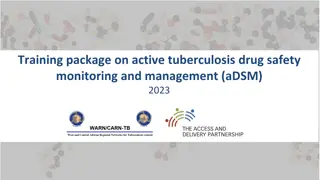Tuberculosis Treatment Completion Among Incarcerated Persons in the U.S. (1999-2008)
Tuberculosis treatment completion among incarcerated individuals is crucial for TB control, with incomplete treatment leading to increased risks. The national target for treatment completion within 12 months stands at 93%. Overall, the completion rate improved but falls short of this goal, with various factors influencing treatment outcomes. The data also highlights the proportion of TB cases in incarcerated persons from 1993 to 2010.
Download Presentation

Please find below an Image/Link to download the presentation.
The content on the website is provided AS IS for your information and personal use only. It may not be sold, licensed, or shared on other websites without obtaining consent from the author. Download presentation by click this link. If you encounter any issues during the download, it is possible that the publisher has removed the file from their server.
E N D
Presentation Transcript
Tuberculosis Treatment Completion Among Persons Incarcerated at Diagnosis, U.S. TB Surveillance System, 1999 2008 Kiren Mitruka, MD, MPH (presented on her behalf by Maryam Haddad) Surveillance, Epidemiology, and Outbreak Investigations Branch ACET Meeting March 7, 2012 National Center for HIV/AIDS, Viral Hepatitis, STD, and TB Prevention Division of TB Elimination
Background: Treatment Completion Treatment completion is a top priority for TB control Interrupted or incomplete treatment increases risk of relapse, transmission, and drug resistance Most forms of TB are treatable within 6 9 months 2015 national target: 93% completion (COT) within 12 months among persons eligible for COT 12 months
Background: National TB Surveillance National TB Surveillance System (NTSS) began to collect reason therapy stopped (treatment outcome) in 1993 Also in 1993, NTSS began recording whether patient residing in correctional facility at time of TB diagnosis Federal prison, state prison, local jail, juvenile facility, other In 2009, additional variable to ascertain whether under custody of Immigration and Customs Enforcement (ICE)
Overall Treatment Completion Overall proportion of cases ever completing treatment 87% 92% during 1993 2008 Among persons alive at diagnosis, with initial regimens of at least one TB drug, who did not die during treatment Treatment completion within 12 months: 63% Improved but falls short of national goal of 93% Excluded from expectation/calculation of COT 12 months if Not on at least one TB drug, death at diagnosis or during treatment, meningeal disease, pediatric miliary disease or TB bacteremia, or rifampin monoresistance or multidrug resistance (MDR) on initial drug susceptibility testing 85% Source: Mitruka et al. Predictors of failure in timely tuberculosis treatment completion, United States. Accepted by IJTLD, Feb 2012.
Incarcerated Persons as a Proportion of All TB Cases, 1993 2010 30,000 25,000 All TB cases Incarcerated at diagnosis Number of cases 20,000 15,000 10,000 5,000 0 1993 1994 1995 1996 1997 1998 1999 2000 2001 2002 2003 2004 2005 2006 2007 2008 2009 2010 Year
Trends in TB Cases in Incarcerated Persons, 1993 2010 1,200 10 No. of cases in incarcerated persons 9 1,000 8 Percentage of total cases 7 Number of cases 800 Percentage 6 600 5 4 400 3 2 200 1 0 0 Year
Treatment Completion Among Persons Incarcerated at Diagnosis For 1999 2008 cohort, examined treatment outcomes among incarcerated vs. not incarcerated Among all persons alive at diagnosis who started treatment, reason therapy stopped Among persons eligible for completion (COT) in 12 months, stratified by origin (i.e., U.S.-born and foreign-born): completion in 12 months delayed completion (>12 months) no known completion o by facility at diagnosis
Reason TB Treatment Stopped, 19992008, by Incarceration Status (N=143,515) Incarcerated at diagnosis N=4,986 n 3,641 Not incarcerated N=138,390 n 119,505 (%) (73.0) (%) (86.4) Completed treatment ever Died Moved Lost Refused Adverse event 173 364 571 44 (3.5) (7.3) (11.5) (0.9) (0.0) 10,282 3,036 3,078 844 (7.4) (2.2) (2.2) (0.6) (0.0) 0 5 Unknown,other, or missing 193 (3.9) 1,640 (1.2) Note: Included all cases in persons reported as alive at diagnosis and taking one or more TB drugs; 139 cases (0.1% ) had missing incarceration status
Reason TB Treatment Stopped, 19992008, Among Incarcerated, by Origin (N= 4,986) U.S.-born N=3,148 Foreign-born N=1,814 n 1,057 n (%) (81.6) (%) (58.3) Completed treatment Died Moved Lost Refused Adverse event 2,569 142 90 256 25 (4.5) (2.9) (8.1) (1.0) (0.0) 31 (1.7) (14.9) (17.2) (1.1) (0.0) 271 312 19 0 0 Unknown,other, or missing 66 (2.1) 124 (6.8) Note: Of total 4,986 cases among incarcerated persons, 24 had missing data on origin
Treatment Completion in 12 Months by Incarceration Status at Diagnosis* 100 90 80 70 % eligible patients 60 Not incarcerated COT 12 months Incarcerated COT 12 months 50 40 30 20 10 0 1999 2000 2001 2002 2003 2004 2005 2006 2007 2008 Year * Cases were among persons eligible to complete treatment within 12 months: persons had to be alive at diagnosis, initiate TB treatment, not die during treatment, and not have meningeal TB, pediatric (aged <15 years) miliary disease or a positive blood culture for Mycobacterium tuberculosis, or rifampin resistance on initial drug susceptibility testing
Treatment Completion in >12 Months by Incarceration Status at Diagnosis* 100 90 80 70 % eligible patients 60 Incarcerated COT >12 months 50 40 Not incarcerated COT >12 months 30 20 10 0 1999 2000 2001 2002 2003 2004 2005 2006 2007 2008 Year * Cases were among persons eligible to complete treatment within 12 months: persons had to be alive at diagnosis, initiate TB treatment, not die during treatment, and not have meningeal TB, pediatric (aged <15 years) miliary disease or a positive blood culture for Mycobacterium tuberculosis, or rifampin resistance on initial drug susceptibility testing
No Known Treatment Completion by Incarceration Status at Diagnosis* 100 90 80 70 % eligible persons 60 50 Incarcerated no known completion 40 30 20 Not incarcerated no known completion 10 0 1999 2000 2001 2002 2003 2004 2005 2006 2007 2008 Year *Cases were among persons eligible to complete treatment within 12 months: persons had to be alive at diagnosis, initiate TB treatment, not die during treatment, and not have meningeal TB, pediatric (aged <15 years) miliary disease or a positive blood culture for Mycobacterium tuberculosis, or rifampin resistance on initial drug susceptibility testing
Treatment Completion in 12 Months Among Incarcerated, by Origin* 100 90 80 70 % eligible patients 60 50 U.S.-born COT 12 months Foreign-born COT 12 months 40 30 20 10 0 1999 2000 2001 2002 2003 2004 2005 2006 2007 2008 Year *Cases were among persons eligible to complete treatment within 12 months: persons had to be alive at diagnosis, initiate TB treatment, not die during treatment, and not have meningeal TB, pediatric (aged <15 years) miliary disease or a positive blood culture for Mycobacterium tuberculosis, or rifampin resistance on initial drug susceptibility testing
Treatment Completion in >12 Months Among Incarcerated, by Origin * 100 90 80 70 % eligible patients 60 U.S.-born COT >12 months 50 40 Foreign-born COT >12 months 30 20 10 0 1999 2000 2001 2002 2003 2004 2005 2006 2007 2008 Year *Cases were among persons eligible to complete treatment within 12 months: persons had to be alive at diagnosis, initiate TB treatment, not die during treatment, and not have meningeal TB, pediatric (aged <15 years) miliary disease or a positive blood culture for Mycobacterium tuberculosis, or rifampin resistance on initial drug susceptibility testing
No Known Treatment Completion Among Incarcerated, by Origin * 100 90 80 70 % eligible persons 60 50 Foreign- born no known completion 40 30 20 U.S.-born no known completion 10 0 1999 2000 2001 2002 2003 2004 2005 2006 2007 2008 Year *Cases were among persons eligible to complete treatment within 12 months: persons had to be alive at diagnosis, initiate TB treatment, not die during treatment, and not have meningeal TB, pediatric (aged <15 years) miliary disease or a positive blood culture for Mycobacterium tuberculosis, or rifampin resistance on initial drug susceptibility testing
No Known Treatment Completion by Facility Type at Diagnosis and Origin, 1999 2008 U.S.-born Foreign-born n (%)No known completion (14.6) (21.4) (10.8) (16.2) (3.9) n (%)No known completion (40.6) (54.5) (30.8) (32.1) (18.8) Total incarcerated Federal prison State prison Local jail Juvenile corrections Other* Unk/missing 2,965 112 1,003 1,680 1,753 314 130 791 26 16 78 66 (14.1) (27.4) 483 19 (49.3) (0.4) *Other= ICE detention center, Indian reservation facilities, military stockades and jails, federal park police facilities, police lockups temporary holding facilities), and other facilities not included in other specific choices
Conclusions Persons incarcerated at diagnosis are at high risk for not having timely treatment completion Trends in timely completion worsening Failure is largely attributed to no known completion rather than delayed completion Foreign-born at particularly high risk for having no documented completion
Acknowledgment Author of presentation, Kiren Mitruka Data analysis (ongoing), development of presentation Currently on an Epi-Aid for a TB outbreak Steve Kammerer and Bob Pratt Technical support


